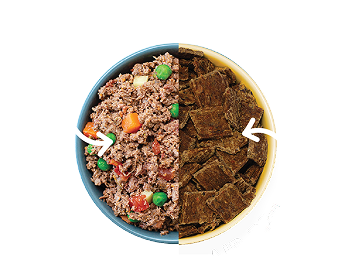
Dog Food for Picky Eaters: How To Get Your Dog To Eat
At A Pup Above, we understand that mealtime can sometimes feel like a battleground rather than a banquet, especially with picky eaters in the mix. Every dog parent wants to see their dog happily chowing down, but what happens when your dog turns up their nose at what’s in the bowl?
This guide is dedicated to helping you transform mealtime from frustration into a feast that even the fussiest eaters will love. Let’s dive into the world of picky eaters and uncover the secrets to a satisfied pup.
What Are the Signs of a Picky Eater?
Is your dog a discerning diner or just not that into dinner? Recognizing a picky eater can sometimes be as simple as observing their behavior around food.
Here’s how you can tell if you have a picky eater on your hands:
- Reluctance To Eat: They may take a few bites and walk away, only to return later — or not at all.
- Snubbing Certain Foods: They turn their nose up at foods they used to enjoy, or ignore new foods entirely.
- Holding Out for Treats: If your dog skips their regular meals but jumps at the chance for treats or table scraps, you might have a picky eater.
Why Being a Picky Eater Isn't Ideal
While a picky eater might seem like they’re just exercising their taste buds, this behavior isn’t ideal for several reasons.
First, it can lead to nutritional imbalance. Dogs that dodge their balanced meals for more flavorful treats might miss out on essential nutrients needed for their overall health. This selectivity can also foster undesirable behaviors like begging or scavenging, making mealtimes stressful for both pets and their owners.
Additionally, perceived pickiness might actually mask deeper health issues. If a dog suddenly changes their eating habits, it could indicate dental problems or digestive discomfort that requires veterinary attention.
So, if you notice your dog consistently avoiding meals or showing signs of discomfort while eating, it's important to call in the pros.
What Causes a Dog to Become a Picky Eater?
Navigating the nuances of a picky eater can be puzzling. While some dogs wolf down whatever you put in front of them, others might sniff and stroll away, unimpressed.
With this in mind, let’s explore some common causes that might be influencing your dog's appetite:
Taste and Texture Preferences
Just like us, dogs have preferences. Some dogs may prefer moist, meaty meals over dry kibble, while others might favor certain flavors. Texture can also be a big deal, with some dogs disliking the texture of certain foods, which can range from too hard, too soft, or just unfamiliar.
Age-Related Changes
As dogs age, their eating habits can change. Older dogs may develop more refined tastes or become sensitive to textures due to dental issues. Younger dogs, especially puppies, might be more adventurous but can also be more sensitive as they adjust to solid foods.
Improper Feeding Practices
How and when you feed your dog matters. Irregular feeding schedules or too many treats can disrupt normal eating habits. Dogs that are fed table scraps may hold out for more exciting human food rather than their regular dog food, which can reinforce picky behavior.
Psychological Factors
Emotional changes can impact eating behavior, too. Stress, anxiety, or changes in the home environment can make dogs lose their appetite. Dogs that experience separation anxiety, for example, may skip meals more often, especially if they're used to eating with their owner around.
How Can You Encourage Your Picky Eater?
Now that you understand some of the causes behind picky eating, let's explore effective strategies to coax your four-legged friend back to their bowl with gusto.
Stick to a Feeding Schedule
Consistency can change the game. Serving meals at the same time each day and removing the food bowl after 20 to 30 minutes can help reinforce a routine. This encourages dogs to eat when food is available, knowing it won't be there indefinitely.
Limit Treats and Human Food
While treats are great for training and bonding, excessive treats or human food can spoil their appetite for regular meals. Cutting back gradually will help shift their focus back to their own nutritious meals, making them less finicky over time.
High-Quality Diet
Opt for premium, palatable meals that are both nutritious and delicious. At A Pup Above, our sous-vide method gently cooks the meals to lock in flavor and nutrients, making each bite a treat. This method ensures they get a diet that’s as healthy as it is tasty.
Enhance Meal Appeal
Sometimes, all it takes is a little extra something to spark interest in their regular food. Warming the food slightly can release enticing aromas, and adding a splash of bone broth or sprinkling some tasty toppers can make the meal irresistible.
Experiment With Different Flavors
Dogs can get bored with the same flavor day in and day out. Introduce a variety of flavors to keep mealtime exciting. Consider our Sampler Pack, which includes Chicka Chicka Bow Wow, Porky's Luau, Texas Beef Stew, and Turkey Pawella, to see which one your pup prefers the most.
Create a Pleasant Dining Experience
Make sure the feeding area is calm and inviting. A quiet corner away from foot traffic and noise can make mealtime more relaxing and enjoyable for your dog, encouraging them to eat without distractions or stress.
Gradual Introduction to New Foods
When introducing new foods, mix them with the old favorites to acclimate your dog to new tastes and textures. This gradual change can prevent digestive upset and help your dog adjust without overwhelming them.
Interactive Feeding Toys
Consider using fun interactive feeding toys or puzzle feeders that challenge your dog to work for their food. These tools make mealtime fun and engage your dog's mind, slowing down fast eaters and making each meal feel like a rewarding game. This can be particularly appealing for dogs who may otherwise be bored by a standard feeding routine.
Positive Reinforcement
Encourage your pup when they eat their meal. A little praise or a pet can reinforce good behavior. This positive reinforcement can make mealtime a joyful experience for both of you, enhancing your bond.
When Should You Consult a Vet?
While pickiness at mealtime is often just a quirk, it can sometimes be a red flag for underlying issues. If your dog’s eating habits change suddenly or if they exhibit signs of discomfort such as excessive drooling, retching, or disinterest in favorite foods for more than a couple of days, it’s wise to consult a veterinarian.
Persistent refusal to eat can indicate health problems ranging from dental discomfort to gastrointestinal issues that require professional diagnosis and treatment.
A Final Word
At A Pup Above, we believe every meal should be a joyous occasion for your pup. Our mission to transform doggy dining experiences is fueled by our commitment to quality, flavor, and nutrition. With our range of human-grade, sous-vide cooked meals, we ensure your dog not only enjoys their food but also receives the optimal balance of nutrients.
Curious to see the difference? Try our fan favorites like Chicka Chicka Bow Wow, Porky's Luau, Texas Beef Stew, and Turkey Pawella. It’s time to turn mealtime frustrations into feast-time celebrations with A Pup Above, where your dog’s health and happiness are always our top priority.
Join us in making every bite count!
Sources:
Why Is My Dog a Picky Eater? | American Kennel Club
5 Common Dog Illnesses That Are Impacted by Nutrition | The AKC
How do dogs' nutritional needs change as they age? | HowStuffWorks
Top Stories

Why Do Dogs Lick Their Paws?

Why Do Dogs Whimper & Make Noises in Their Sleep?

Healthy Vet-Approved Homemade Dog Food Recipes

How To Cook Sweet Potatoes for Dogs






















